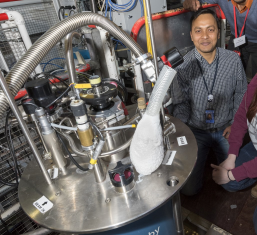Conveners
Superconductivity II
- Adrian Hillier (STFC)
Low carrier density superconductors have emerged as intriguing subjects of study, as they challenge our existing understanding of superconductivity while offering valuable insights into its underlying mechanisms. The complex structure of the Remeika phases, coupled with the superconductivity and low carrier concentrations, presents a unique opportunity to investigate the superconducting ground...
The superconducting gap structure of the topological superconductor candidates ZrRuAs and HfRuP with a noncentrosymmetric crystal structure has been investigated using muon-spin rotation/relaxation (μSR) measurements in transverse-field (TF) and zero field (ZF) geometries [1, 2]. Magnetization and electrical resistivity measurements reveal bulk superconductivity below a superconducting...
In the recent search for unconventional- and topological superconductivity, noncentrosymmetric superconductors (NCSCs) are among the most promising candidate materials. Surprisingly, some of them - especially those containing rhenium - seem to exhibit also time-reversal symmetry (TRS) breaking in their superconducting state, while TRS is preserved in many other isostructural NCSCs. To date, a...
Time-reversal symmetry breaking (TRSB) in superconductors is manifested by the spontaneous appearance of small magnetic fields in the superconducting state, and can be detected using techniques such as muon-spin relaxation (μSR) or measurements of the Kerr effect. The most notable examples of such superconductors are a handful of strongly correlated magnetic materials, such as Sr2RuO4 and some...

